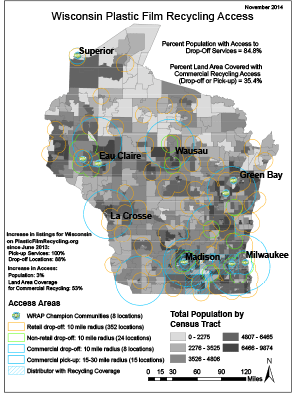Keeping Bags at Bay with Bans, Fees, Education and Labeling
Ah the plight of the much-maligned, single-use plastic grocery bag. Hawaii has essentially banned them and California’s legislation to follow suit has gone to a referendum.
Arizona just outlawed such bag bans, and Missouri is considering similar legislation.
Meanwhile, New York City and Philadelphia might fall into line with Washington, D.C.; Boulder, Colo.; and Portland, Maine; by charging shoppers a fee of a nickel or a dime for each bag.
Impassioned legislators rant as if the choice between paper and plastic is embedded somewhere in the Constitution. Conservationists fret that these long-lived petroleum products not only clog rivers and oceans but also sully tree branches and landscapes when they become airborne. And ordinary homeowners lament that they will be denied trashcan liners and dog poop scoopers.
How is it that these flimsy fragments of film, these urban tumbleweeds, send so many into paroxysms?
 “People get really emotional about their bags,” says Julie Lawson, director of Trash Free Maryland, an alliance of more than 60 like-minded local organizations. “They’re on autopilot about lots of things and really resistant to change.”
“People get really emotional about their bags,” says Julie Lawson, director of Trash Free Maryland, an alliance of more than 60 like-minded local organizations. “They’re on autopilot about lots of things and really resistant to change.”
That recalcitrance is why unflappable heads such as Lawson and Nina Butler, managing director at Sonoma, Ca.-based Moore Recycling Associates, deploy a mix of psychology, math and carrots to change behavior and keep plastic in its place.
“The ideal scenario is that we educate people about recycling all film beyond plastic bags,” Butler tells Waste 360 in an interview. “We recognize it’s a valuable material. We should be putting it back into the economy because the market demand is huge. And that doesn’t mean we encourage using film in a cavalier way.”
For instance, Butler says, most people are clueless that collection bins outside grocery stores and retailers also accept air-filled packing pillows; sandwich, bread, drycleaner and newspaper bags; and the plastic that seals bulk cat food cans and rolls of paper towels and toilet tissue. It’s crucial that all bins and film be clearly labeled, she adds.
Research by Moore, which receives funding from the American Chemistry Council (ACC), reveals that plastic bags and wraps were a mere 13 percent—149 million pounds—of the 1.14 billion pounds of post-consumer film collected in this country in 2013. Butler is convinced that total can be doubled to 2 billion pounds by 2020 by boosting awareness and access and curing apathy.
That’s why she’s a force behind the Wrap Recycling Action Program (WRAP), launched in 2013 by the ACC’s Flexible Film Recycling Group. WRAP encourages collaboration among communities, businesses, universities, hospitals, retailers and materials recovery facilities (MRFs). For instance, a Wisconsin pilot program has significantly increased commercial access to film recycling.
Butler and Lawson agree that curbside collection of film is disastrous because it is so easily contaminated and gums up MRF machines.
Likewise, they view bag fees as benevolent, especially when the money is directed toward education, anti-pollution efforts and promoting reusable totes. Lawson, who was instrumental in initiating a five-cent bag fee in the nation’s capital in 2010, says household bag use has dropped 60 percent there since 2009.
Statewide bans on plastic bag bans are irksome because they prevent progressive communities from solving a specific trash headache, Lawson says.
“We talk about a choice between paper and plastic at the grocery store,” she says. “Shouldn’t people have a choice about how their communities deal with plastic bags?”
Butler fears outright bans will choke off some of the estimated 18,000 collection sites now accessible to most citizen recyclers. For instance, after California banned plastic bags in 2014, a Moore spotcheck of 88 grocery and retail stores statewide found that 39 percent of the stores had removed collection bins.
“What’s good about them is what’s bad about them,” Butler says about plastic bags. “They’re lightweight, which is what makes film the best material if you’re shipping anything and want to reduce loss. But if they’re not handled properly, they can have a lot of negative consequences. It’s complicated.”
Statistics gathered by Moore show that 48 percent of the used film collected nationwide in 2013 was turned into composite lumber and 43 percent was reborn as new film. Butler has no doubt that industry is champing at the bit for recycled feedstock to churn out even more lumber, benches, playground equipment, containers and pipes.
Lawson understands the need for useful plastic.
“I’m not opposed to plastic, I’m opposed to stupid plastics,” she emphasizes. “It’s way too versatile to be used for 12 minutes as a bag and then thrown away. At the end of the day, my job is to prevent these bags from polluting the water.”
It’s wonderful, Lawson says, that people are learning that storefront receptacles can accept a range of film products. However, she had a hearty laugh recently when a plastics recycler admitted that some bread bags they received still contained not just crumbs—but entire loaves.
Clearly, the educating isn’t finished.
About the Author
You May Also Like


